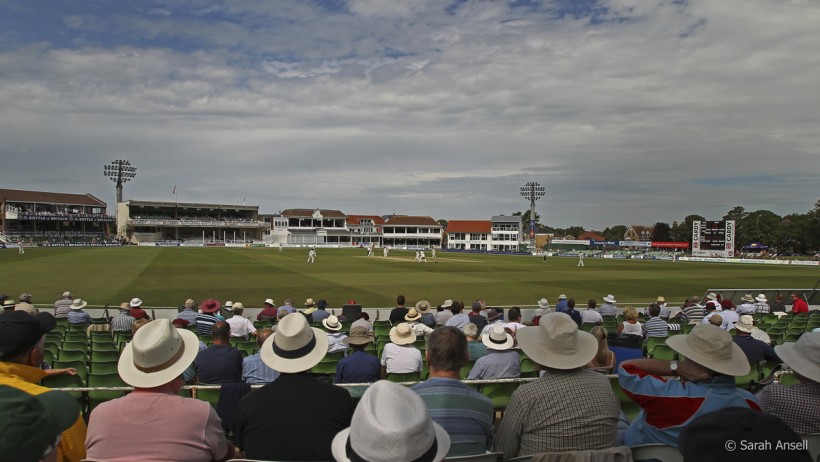Patrick Collins: Canterbury Week a beguiling ritual
Saturday 6th August 2016

Five-times Sports Writer of the Year PATRICK COLLINS takes a personal and affectionate look at what makes Canterbury Week a special part of the sporting calendar…
A few years ago, in the course of an essay on Cricket Week at Canterbury, I suggested that some saw it as: “A place for people who are still coming to terms with the death of King Edward VII, a theme park for vaguely distressed gentlefolk, who find the sport engaging but would really rather be pacifying the North-West Frontier or civilising the dusty outback”.
The following summer, I was approached by an elderly Kent member who offered a few courteous observations about the piece. As he spoke, a wistful memory crossed his mind. “D’you know?” he said, “my grandfather was once presented to Edward VII. He said he was a very fine king.”
Now you might overhear a similar remark in, say, The House of Lords library or at the bar of a Pall Mall club, but Canterbury is one of the few sporting arenas where such an observation seems quite unremarkable. And never more so than in Cricket Week.
It is a week awash with regimental ties and Panama hats, picnic baskets and trestle tables and billowing marquees full of thirsty corporates and intriguing societies: Hopper’s Tie Club, The Band of Brothers. One is reserved for The Old Stagers, the oldest amateur dramatic society in the world, which has been adorning the occasion since the first Canterbury Week in 1842.
This year, at the Gulbenkian Theatre, they are presenting Gogol’s ‘The Government Inspector’, and at the end of the week they will be offering their ‘topical musical revue’.
The 2016 festival matches comprise a Royal London One-Day Cup contest against Gloucestershire and a Specsavers County Championship game with Worcestershire.
The fact that the four-day match will clash with both England’s Third Test against Pakistan and the opening of the Rio Olympics seems of little consequence, since this festival was thriving long before the creation of Test match cricket or the modern Olympics.
Much of the Week’s noise and enthusiasm will be generated on the so-called ‘popular sides’, square of the wicket, while in stands named after the Kentish gods Cowdrey, Ames and Woolley, county ladies will sit with chin propped in palms as their husbands browse the Telegraph and contemplate lunch.
While their elders devour the festival fare, the children will invade the field to swing hearty hoicks at dreamy lobs, while the public address bawls its agitated instruction: “No hard balls, please!” – itself a Canterbury tradition.
Yet always there is that lingering affection for the past, and sometimes it emerges in strangely touching fashion. On the opening day this year, in line with tradition, a wreath will be laid at the Lime Tree to remember the fallen from two world wars.
Once the redevelopment of this ancient ground is completed, the ceremony will once again take place at the (currently in storage) memorial to Colin Blythe who, between 1899 and 1914, took 2,503 first-class wickets at 16 runs apiece with his left-arm spin. In 19 Tests for England, he took 100 wickets at 18. Of Blythe, Ranjitsinhji said: “He was finer even than Rhodes, the deceptive flight making him far more difficult to hit”, while Jessop called him “the best left arm of my time, or any time”.
But on the night of November 8, 1917, Blythe was laying temporary rail tracks around the village of Passchendaele, when a German shell exploded above his working party and a splinter of shrapnel pierced his heart. He was 38. This is the massively-gifted, much-loved man whom Kent will be remembering again, among many others, during Canterbury Week.
Ladies’ Day will once again feature its Fashion on the Outfield competition, a multi-coloured riot of frocks, fronds and feathers. Competitors parade before a panel of judges, often balancing all manner of exotic decorations upon their heads while flashing winning smiles.
In the year I attended the Week for the purposes of my little essay, it was gate-crashed by a cross-dresser in green chiffon, a cheeky little pillbox hat and a deep voice which boomed: “Ladies, you all look stunning!”
He was later revealed as a member of a stag party. It emerged that the group had formally applied to the Kent committee for permission to wear dresses and, after discussion, permission was granted. If you were searching for a definition of ‘Englishness’, you need look no further.
It is this intangible quality, indeed, which has been drawing them to the festival every year since 1842, save for the tragic intrusions of those two world wars.
The late William Deedes, Cabinet minister and newspaper editor, understood precisely the significance of this beguiling ritual in the heart of his native county when, in August 1999, he wrote: “Around this time of year, while the Second World War was on, I consoled myself by thinking that Canterbury Cricket Week, founded in 1842 with its tents and famous lime tree, unchanging in a changing world, was the sort of thing I was in business to preserve.
“Most of us had daydreams like that in those days. This year, I took a long look around the ground between the showers. Then I caught sight of a programme for the 149th season of The Old Stagers at Canterbury’s Gulbenkian Theatre, which accompanies the Week – they were playing Ronald Gow’s version of the Sackville-West novel The Edwardians. And there was the lime tree. A dream come true.”
Patrick Collins, a regular visitor to Canterbury to watch Kent, is a former chief sports writer of the Mail on Sunday and a five-times winner of the Sports Writer of the Year Award.
